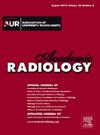Growth Prediction of Ground-Glass Nodules Based on Pulmonary Vascular Morphology Nomogram
IF 3.8
2区 医学
Q1 RADIOLOGY, NUCLEAR MEDICINE & MEDICAL IMAGING
引用次数: 0
Abstract
Rationale and Objectives
To construct a nomogram combining conventional CT features (CCTFs), morphologically abnormal tumor-related vessels (MATRVs), and clinical features to predict the two-year growth of lung ground-glass nodule (GGN).
Methods
High-resolution CT targeted scan images of 158 patients including 167 GGNs from January 2016 to September 2019 were retrospectively analyzed. The CCTF and MATRV of each GGN were recorded. All GGNs were randomly divided into a training set (n = 118) and a validation set (n = 49). Multiple stepwise regression was used to select the features. Multivariate logistic regression was used to construct the CCTF, CCTF-CTRV (category of tumor-related vessel), and CCTF-QTRV (quantity of tumor-related vessel) nomograms. The performance and utility of the nomograms were evaluated using the area under the receiver operating characteristic curve (AUC), net reclassification improvement (NRI), integrated discrimination improvement (IDI), and decision curve analysis (DCA).
Results
The AUC of the CCTF-QTRV nomogram, which included the features of smoking history, nodule pattern, lobulation, and the number of distorted and dilated vessels, was higher than the AUCs of the CCTF and CCTF-CTRV nomograms in both the training set (AUC: 0.906 vs. 0.857; vs. 0.851) and the validation set (AUC: 0.909 vs. 0.796; vs. 0.871). DCA indicated that both patients and clinicians could benefit from using the nomogram.
Conclusion
The nomogram constructed by combining MATRV, CCTF, and clinical information can more effectively predict the two-year growth of GGNs. This integrated approach enhances the predictive accuracy, making it a valuable tool for clinicians in managing and monitoring patients with GGNs.
基于肺血管形态图的磨玻璃结节生长预测。
依据与目的:结合常规CT特征(cctf)、肿瘤相关血管形态学异常(matrv)及临床特征,构建肺磨玻璃结节(GGN) 2年生长预测图。方法:回顾性分析2016年1月至2019年9月收治的158例ggn患者的高分辨率CT靶向扫描图像,其中167例ggn。记录各GGN的CCTF和MATRV。所有ggn随机分为训练集(n = 118)和验证集(n = 49)。采用多元逐步回归选择特征。采用多元logistic回归构建CCTF、CCTF- ctrv(肿瘤相关血管种类)和CCTF- qtrv(肿瘤相关血管数量)图。使用受试者工作特征曲线下面积(AUC)、净重分类改善(NRI)、综合判别改善(IDI)和决策曲线分析(DCA)来评估nomogram的性能和效用。结果:CCTF- qtrv图的AUC(包括吸烟史、结节类型、分叶分布、扭曲和扩张血管数量)均高于CCTF和CCTF- ctrv图的AUC (AUC: 0.906 vs. 0.857;对比0.851)和验证集(AUC: 0.909 vs 0.796;比0.871)。DCA表明,患者和临床医生都可以从使用nomographic中获益。结论:结合matv、CCTF及临床信息构建的nomogram可以更有效地预测ggn的2年生长情况。这种综合方法提高了预测的准确性,使其成为临床医生管理和监测ggn患者的宝贵工具。
本文章由计算机程序翻译,如有差异,请以英文原文为准。
求助全文
约1分钟内获得全文
求助全文
来源期刊

Academic Radiology
医学-核医学
CiteScore
7.60
自引率
10.40%
发文量
432
审稿时长
18 days
期刊介绍:
Academic Radiology publishes original reports of clinical and laboratory investigations in diagnostic imaging, the diagnostic use of radioactive isotopes, computed tomography, positron emission tomography, magnetic resonance imaging, ultrasound, digital subtraction angiography, image-guided interventions and related techniques. It also includes brief technical reports describing original observations, techniques, and instrumental developments; state-of-the-art reports on clinical issues, new technology and other topics of current medical importance; meta-analyses; scientific studies and opinions on radiologic education; and letters to the Editor.
 求助内容:
求助内容: 应助结果提醒方式:
应助结果提醒方式:


